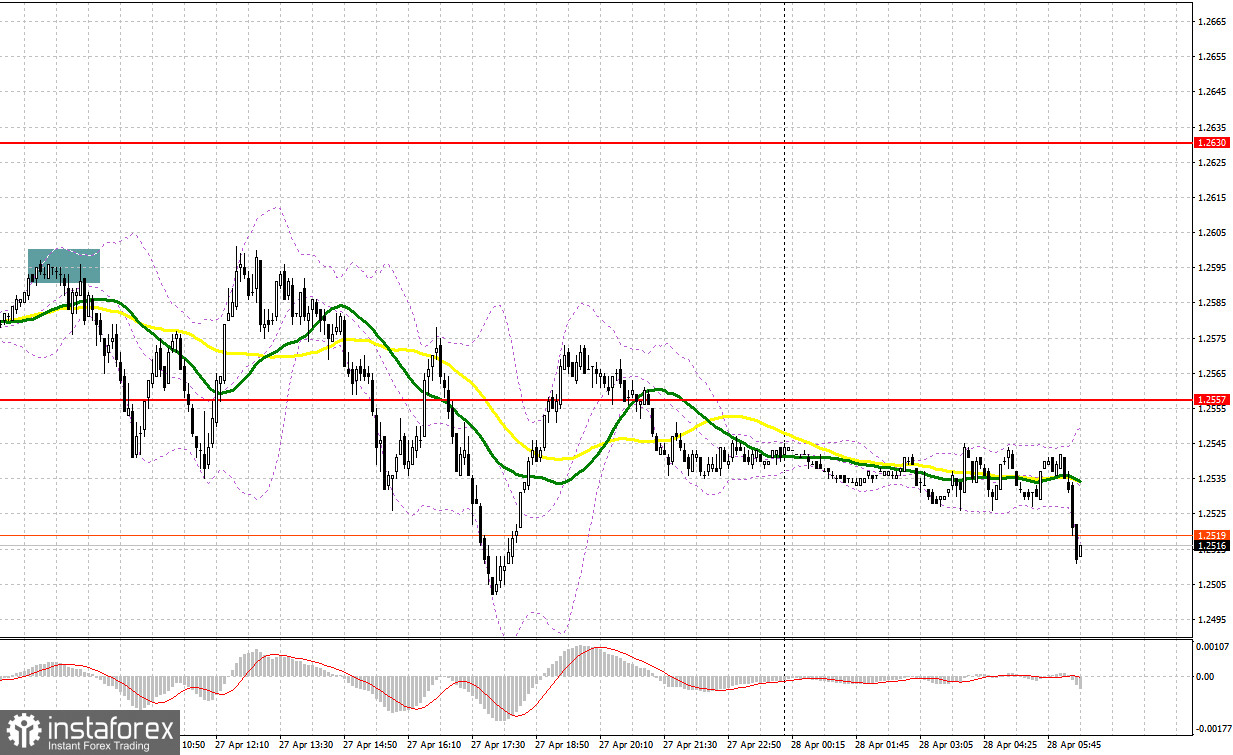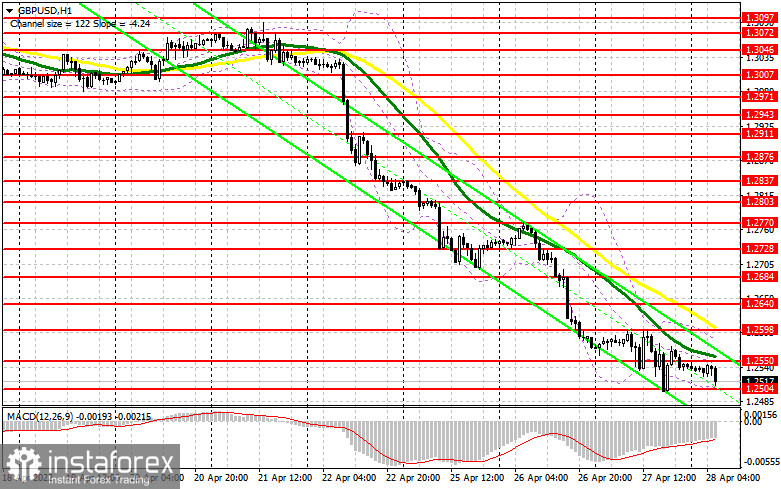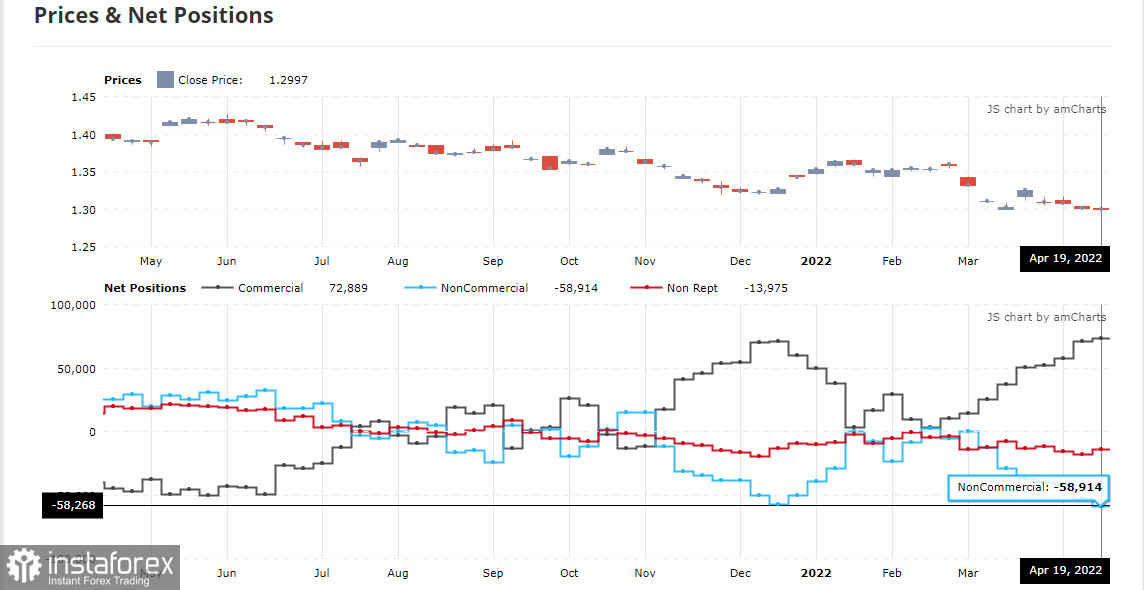Yesterday, only one signal was formed to enter the market. Let's look at the 5-minute chart and figure out what happened. I paid attention to the 1.2590 level in my morning forecast and advised you to make decisions on entering the market from it. A slight upward movement of the pound to the resistance area of 1.2590 along with a false breakout – all this led to forming another sell signal in continuation of the downward trend. As a result, the pair collapsed by more than 60 points, but just a couple of points were not enough to reach the target support level. Despite the revision of the technical picture for the second half of the day, we could not wait for new signals for entering the market. The price was always far enough away from the target level of 1.2557, relying on which no suitable entry points were formed.

When to go long on GBP/USD:
The bulls actively defending the 25th figure allows us to hope that they will still be able to stop, or at least slow down the downward trend observed since the end of last week. Of course, there are objective reasons for this, since nothing good is happening in the world that would help investors regain demand for risky assets. Quarantine restrictions in China, high inflation in the UK, along with the crisis in the Brits' cost of living – all this will continue to put pressure on the pound as the Bank of England will continue to raise rates, risking driving the economy into recession. The increase in interest rates makes borrowing more expensive, which negatively affects the economy, which is suffering greatly from inflation and a sharp slowdown in consumer demand. For this reason, I recommend taking your time with long positions even at current lows. You can count on a false breakout in the area of the next intermediate support of 1.2504 within the day, where the pound was actively bought yesterday. If the bulls manage to recapture this range again, then it's time to talk about trying to find the bottom. After that, you can bet on the pair's recovery to 1.2550, where the moving averages are playing on the bears' side. A breakthrough and consolidation above this range with a reverse test will provide an entry point into long positions, counting on growth in the area of 1.2598, where I recommend taking profits. It is also possible to count on a more active upward movement against the background of the lack of statistics for the UK, which has recently only hindered the pound. In case the pair falls and people are not willing to buy at 1.2504, and most likely that's the case, I advise you not to force events and hold back from long positions against the trend until the next larger support of 1.2450. But even there you need to wait for a false breakout. It is possible to open long positions immediately for a rebound only in the area of 1.2386, counting on an upward correction of 25-30 points within the day.
When to go short on GBP/USD:
The main goal for today is to surpass the nearest support of 1.2504, since regaining control of this level will completely transfer control of the market, and updating the next annual low can preserve the bear market. A breakthrough and a reverse test of 1.2504 from the bottom up creates a sell signal, which will quickly push GBP/USD into the 1.2450 area, where there will be even fewer people willing to buy. A similar breakdown of this range will strengthen the bear market, with the prospect of reaching a low like 1.2386, where I recommend taking profits. A more distant target will be the 1.22321 area, but this is something out of a series of fiction. In case the pound grows, the bears will try to do everything to prevent an exit above the resistance of 1.2550. But even if this happens, there is no need to panic. Forming a false breakout there will be an excellent signal for short positions in order to continue the bear market. If traders are not active around 1.2550, the bulls will try to push the pound even higher. Then I advise you to postpone short positions until the next major resistance of 1.2598. I also advise you to open short positions there only in case of a false breakout. It is possible to sell GBP/USD immediately for a rebound from a high like 1.2640, counting on the pair's rebound down by 30-35 points within the day.

COT report:
The Commitment of Traders (COT) report for April 19 showed that both short and long positions have increased, but there were much more of the former, which is obvious if you look at the GBP/USD chart. The UK economy is in very bad shape, as Bank of England Governor Andrew Bailey confirmed last week. His statements that the economy is heading into recession were the last straw holding back pound bears in the second half of April. As a result, surpassing the annual low and a new major sell-off of the pound has already driven the trading instrument below the 26th figure, and it seems that this is not the end. The consumer price index is climbing steadily into double digits, and a worsening global situation due to disruptions to supply chains amid a new wave of Covid-19 in China creates even more problems. The situation will only get worse, as future inflationary risks are now quite difficult to assess also due to the difficult geopolitical situation, but it is clear that the consumer price index will continue to rise in the coming months. The situation in the UK labor market, where employers are forced to fight for each employee, offering ever higher wages, is also pushing inflation higher and higher. The pressure on the pound is also growing for another reason - the aggressive policy of the Federal Reserve. The Committee may announce an increase in interest rates immediately by 0.75% during the May meeting - they do not have such problems as in the UK with the economy yet. The April 19 COT report indicated that long non-commercial positions rose from 35,514 to 36,811, while short non-commercial positions jumped from 88,568 to 95,727. This led to an increase in the negative value of the non-commercial net position from - 53,054 to -58,268. The weekly closing price fell from 1.3022 to 1.2997.

Indicator signals:
Trading is conducted below the 30 and 50-day moving averages, which indicates the continuation of the bearish trend.
Moving averages
Note: The period and prices of moving averages are considered by the author on the H1 hourly chart and differs from the general definition of the classic daily moving averages on the daily D1 chart.
Bollinger Bands
In case of growth, the upper limit of the indicator around 1.2580 will act as resistance. In case of a decline, the lower limit of the indicator around 1.2504 will act as support.
Description of indicators- Moving average (moving average, determines the current trend by smoothing out volatility and noise). Period 50. It is marked in yellow on the chart.
- Moving average (moving average, determines the current trend by smoothing out volatility and noise). Period 30. It is marked in green on the chart.
- MACD indicator (Moving Average Convergence/Divergence — convergence/divergence of moving averages) Quick EMA period 12. Slow EMA period to 26. SMA period 9
- Bollinger Bands (Bollinger Bands). Period 20
- Non-commercial speculative traders, such as individual traders, hedge funds, and large institutions that use the futures market for speculative purposes and meet certain requirements.
- Long non-commercial positions represent the total long open position of non-commercial traders.
- Short non-commercial positions represent the total short open position of non-commercial traders.
- Total non-commercial net position is the difference between short and long positions of non-commercial traders.





















